Do you know that paint protection film thickness ranges from 6 to 10 mils? This measurement, just one-thousandth of an inch, is critical for your car’s paint protection. High-quality PPF makes your car look better and guards it against wear and tear. This includes scratches and stone chips that can lower its value, impacting the level of protection your vehicle has.
It’s important to choose the right Paint Protection Film thickness for full protection. The protective film is essential for maintaining your vehicle’s appearance. The right thickness shields your vehicle from damage on the road. For advice on the best PPF for you, Pro-Tech Auto Shield & Nano Coatings offers personalized tips. They consider how you drive and where you go.
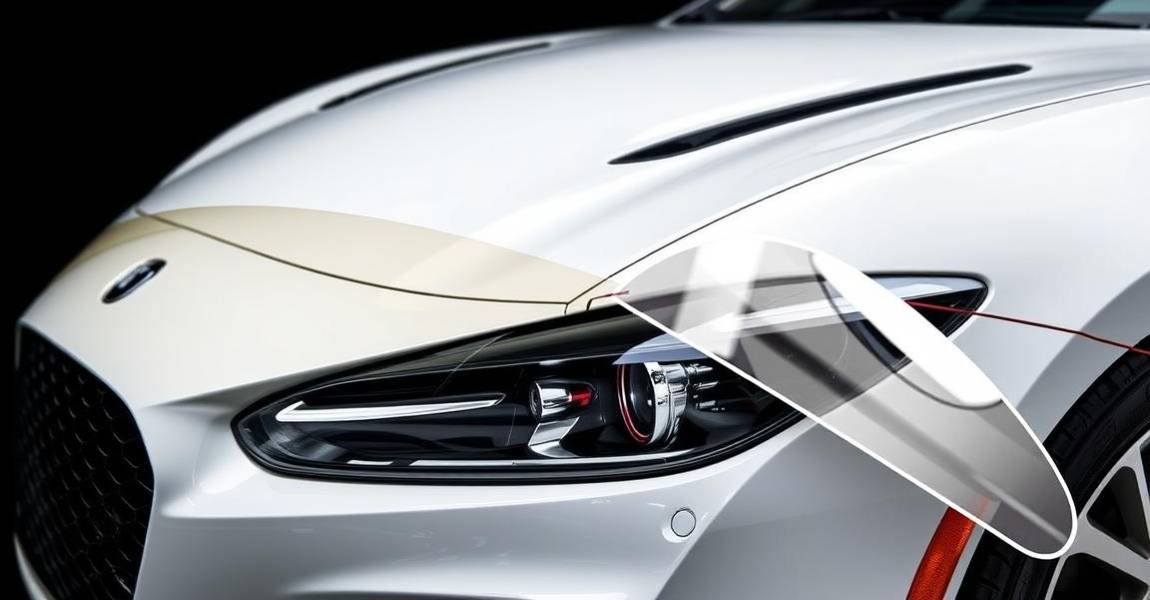
Key Takeaways Paint Protection Film Thickness
- PPF thickness generally ranges from 6 to 10 mils, affecting durability and protection levels.
- Professional installation ensures a flawless finish and longevity of PPF application.
- Thicker PPF films offer enhanced protection against chips and scratches, ideal for driving on rough conditions.
- Self-healing properties in certain PPFs allow for minor scratches to disappear over time.
- Investing in high-quality PPF can preserve your vehicle’s value and aesthetic appeal.
Table of Contents
The Importance of Paint Protection Film (PPF)
Paint Protection Film (PPF) is crucial for keeping your car’s paint looking new. It guards against road debris, protection against environmental factors, and daily use. This layer of paint protection film acts as a barrier, keeping the car free from scratches, scuffs, and chips.
The benefits of paint protection film are not just about looks. Thanks to technology advancements, PPF is now more durable and effective. It includes UV protection and can heal itself from minor scratches, keeping your car’s color bright. Plus, it adds to your car’s resale value by maintaining the paintwork.
PPF’s thickness, between 6-8+ mil, helps absorb impacts from the road. This means less touch-ups and paint jobs, saving money over time. With new improvements, PPF is also easier to install and fight stains, making it accessible for more car owners.
Knowing the balance between protection and aesthetics is crucial when selecting a professional paint protection film. The importance of PPF helps you make smart choices to protect your car’s paint. It’s essential in today’s tough driving conditions. Check out our Ultimate Guide to Car Paint Protection Types.
| Aspect | Details |
|---|---|
| UV Protection | Protects against sun damage |
| Self-Healing | Scratches disappear with heat |
| Thickness | Typically 6-8+ mil thick |
| Durability | Resists scuffs, chips, and scratches |
| Investment | Maintains vehicle resale value |
If you want to protect your vehicle, Pro-Tech Auto Shield & Nano Coatings at 303-423-2841 provides high-quality PPF installation. They ensure your car performs and looks its best.
Understanding Paint Protection Film Thickness
The The thickness of paint protection film plays a crucial role in ensuring optimal protection against damage. is key for vehicle protection. It’s measured in mils, where one mil equals 0.001 inches. Most films are between 4 to 12 mils thick. Thicker films offer better defense against damage but might change how your car looks. It’s important to balance strong protection with the car’s appearance.
Materials like polyurethane (PU) make paint protection strong and long-lasting. Thickness varies between brands and their measuring methods. Differences in measuring tools, like calipers or micrometers, can affect thickness readings. How well the film fits and is applied also matters a lot for its effectiveness.
Although thicker films are preferred for better protection, don’t forget about other features. Some films can heal small scratches themselves and help prevent paint fading. When choosing a film, look at its type, features, and make sure it’s installed well. This will help you get the most out of your paint protection film.
| Film Type | Thickness Range (mils) | Protection Level | UV Resistance | Self-Healing Properties |
|---|---|---|---|---|
| Polyurethane (PU) | 8 – 12 | High | Yes | Yes |
| Thermoplastic PolyOlefin (TPO) | 4 – 8 | Medium | Yes | No |
| Vinyl Wrap | 4 | Low | No | No |
Factors Influencing Thickness and Durability of Paint Protection Film
The thickness of paint protection film (PPF) significantly affects both durability and protection. Knowing the factors influencing PPF thickness helps in choosing the right care for your vehicle. PPF thickness is often measured in mils, with one mil being 0.001 inches. Films thicker than eight mils offer better protection against damage like stone chips and scratches, making them last longer.
Many aspects determine the best PPF thickness for optimal protection. The type of vehicle plays a huge role; luxury or high-performance cars usually need thicker films. This is because they face more challenging conditions. Driving on gravel roads or in tough weather means a thicker PPF is better.
Looks matter too in selecting PPF thickness. Some prefer the invisible look of thin films, while others choose thicker films for more protection. Cost is crucial too; spending more on quality materials can save money on paint repairs later. Continue reading our Cost-Benefit Analysis of Car Paint Protection Film.
The success of PPF also depends on professional installation. An expert install guarantees the film fits perfectly, with no wrinkles or air bubbles. This makes sure it protects as well as possible. Yet, UV rays, humidity, and temperature changes can harm the film over time. This can cause yellowing or weakening. So, following the manufacturer’s care instructions is essential to keep the PPF effective.
Choosing PPF involves thinking about these factors influencing PPF thickness. It’s not just about how it looks now, but how well it protects over time.
Common Thickness Measurements for PPF
When looking into paint protection film (PPF), it’s key to grasp the usual thickness. PPF varies from 4 to 10 mils, matching different needs.
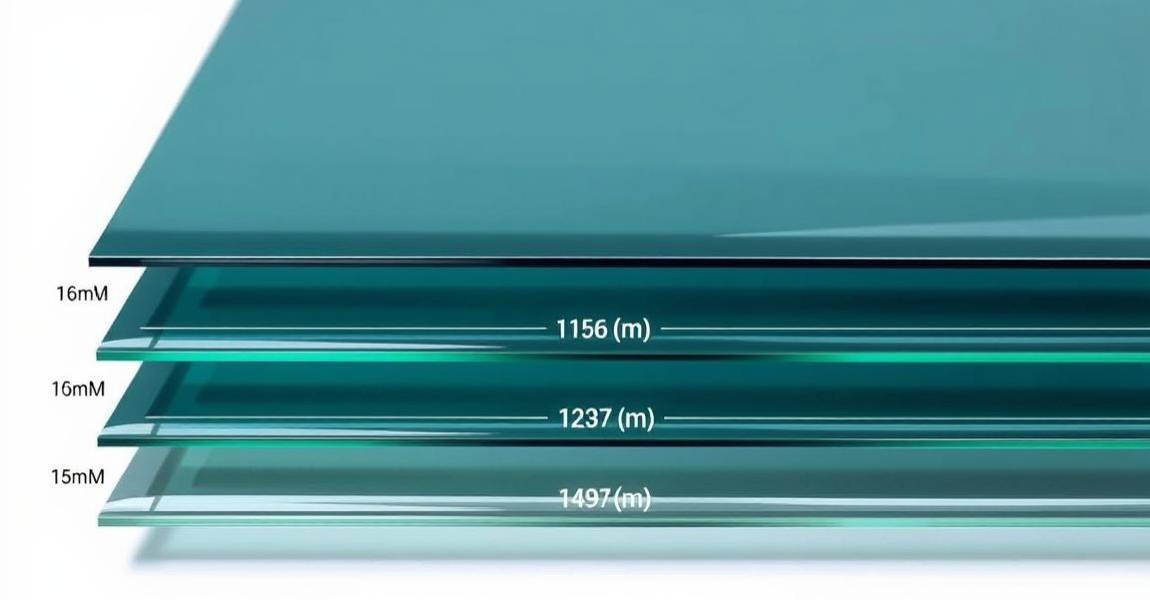
- 4 mils: This is the basic level, perfect for cars not seeing much action.
- 6 mils: A step up, it’s great for regular driving, guarding against common dangers.
- 8 mils: Best for high-end or sporty cars, it adds more shield against road debris.
- 10 mils: The top level, it offers the best defense, especially in harsh conditions.
The best thickness depends on how and where you’ll drive your car. Also, think about PPF’s lifetime, which is about 5 to 10 years, to make an informed decision.
Choosing wisely can make a big difference. To boost PPF’s strength with ceramic coatings, check out this piece.
Thickness and Durability of Paint Protection Film
Choosing the right thickness for paint protection film (PPF) is key. It deeply affects its durability and how well it works. Thicker films are better at preventing scratches, impacts, and damage. They’re often chosen for top-notch cars and fancy vehicles.
Impact of Thickness on Durability
PPF thickness can vary from 6 mils to 10 mils. The thicker it is, the more durable it becomes. Thicker films last longer because they resist daily wear and tear better. Films around 8 to 10 mils are incredibly durable, perfect for high-impact areas.
How Thickness Affects Protection Levels
A thicker film means more protection, which is important for vehicles that face many road hazards. For parts like the front bumper or hood edge, a thickness near 10 mils is ideal. Thicker films reduce damage while fully protecting your car’s paint.
High-Gloss vs. Matte Finish
Your choice between high-gloss vs matte finishes also ties to the film’s thickness. High-gloss PPF makes the vehicle’s color pop and shine. Matte films, however, have a special look. In either case, a thicker film provides better durability and wear resistance.
Self-Healing PPF
Some PPFs come with self-healing tech. This means they can fix minor scratches and marks on their own with heat. Self-healing PPF keeps your car looking new longer.
Vinyl Wraps
It’s important to know how PPF and vinyl wraps differ. Vinyl wraps are thinner and not meant for protection. PPF is thicker and made to protect your car’s original paint. Deciding between them starts with understanding thickness and durability.
If you’re thinking about PPF, get advice from pros. Contact Pro-Tech Auto Shield & Nano Coatings at 303-423-2841. They can help you choose the right thickness for your needs.
| Thickness (mils) | Durability | Protection Level | Best For |
|---|---|---|---|
| 6 mils | Moderate | Standard | Vehicles with low exposure |
| 8 mils | High | Enhanced | Most consumer vehicles |
| 10 mils | Very High | Superior | High-performance and luxury vehicles |
Choosing the Right PPF Thickness for Your Vehicle
Picking the right paint protection film thickness is vital. It’s crucial to consider how often and where your car is driven. The aim is to protect your car’s paint and make it look better.
Factors To Consider When Choosing A Premier Paint Protection Film
When choosing a premier paint protection film, consider the thickness as it directly impacts the film’s ability to absorb impacts and protect your vehicle’s paint from scratches and chips. Durability is equally important, as a high-quality film should resist yellowing, cracking, and peeling over time, ensuring long-lasting protection.
Assessing Your Vehicle’s Usage
To pick the correct PPF thickness, think about how you use your car. If you drive mainly on smooth highways, a thinner PPF works. This is usually between 8 to 10 mils. For high-performance cars or driving on bumpy roads, go for a thicker 10 to 12 mil film.
Evaluating Driving Conditions and Environmental Factors
Driving conditions are key in choosing PPF thickness. If you drive where there’s lots of debris or bad weather, a thicker PPF is needed. It helps protect better.
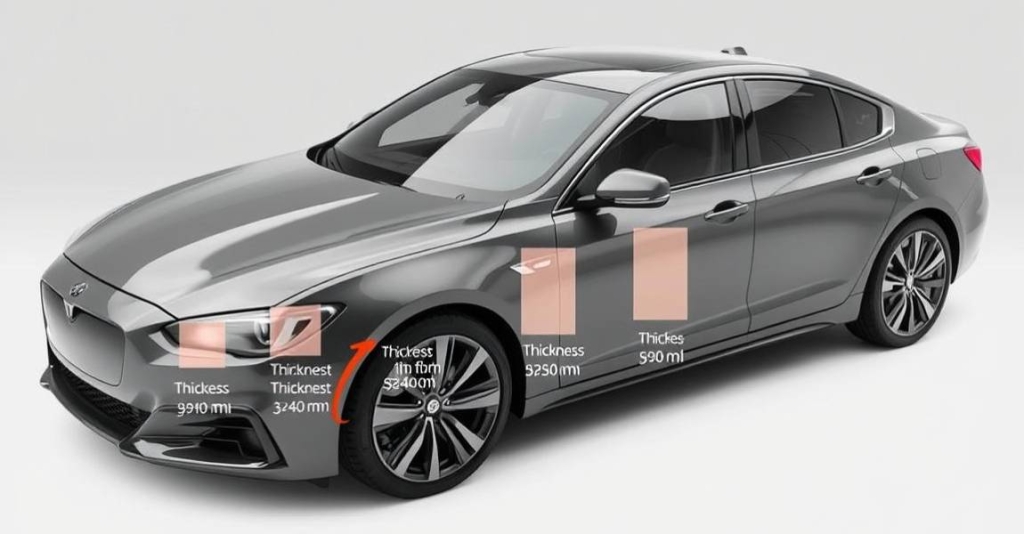
For those dealing with tough weather or lots of scratches, thicker PPF is a smart choice. Although it’s more expensive, it offers better protection.
| PPF Thickness (mils) | Protection Level | Best Use Cases |
|---|---|---|
| 8 – 10 | Moderate protection | Well-maintained roads, light conditions |
| 10 – 12 | High protection | Rugged conditions, off-roading, extreme weather |
Picking the right PPF before installation will keep your car safe for a long time. Choose high-quality PPF and professional installation to boost your car’s value. For further information on paint protection films, visit this comprehensive guide about Does Installing Paint Protection Film Boost Your Car’s Resale Value.
Professional Installation: A Key to Optimal Performance
It’s essential to choose a skilled paint protection film installer. This ensures your paint protection film (PPF) lasts long and works well. Skilled technicians use detailed patterns and special methods. This ensures the film fits your car perfectly, avoiding lifting or peeling later on.
Companies like Pro-Tech Auto Shield & Nano Coatings focus on top-notch services. They ensure your car is fully covered, especially the front bumper, hood, and fenders. With their expert installation, you’ll soon need to remember the PPF is even there.
Putting PPF on your whole car usually takes about 5-7 days. This includes steps like cleaning, degreasing, and drying the car to prepare for installation. Quality PPF also has self-healing features. This means it can fix small scratches and marks on its own.
To get the best results, you need the right tools. These include:
- Premium quality paint protection film
- Soapy water
- Isopropyl alcohol
- Cutter knife
- Measuring tape
- Air release pen
- Squeegee
- Microfiber cloth
Spending time and money on a good installation makes your PPF work better and last longer. Talking to expert installers is smart. They can guide you through new PPF advances, which make the film look better, resist stains, and apply more easily.
High-Quality Paint Protection Film Installer
A high-quality paint protection film installer ensures precise application with no bubbles, seams, or imperfections, preserving your vehicle’s pristine look. They use top-grade materials and have extensive experience, guaranteeing the film’s longevity and optimal performance.
Maintenance Tips for Long-lasting PPF
Proper care for your paint protection film (PPF) is key to keeping it in top shape. By following some easy maintenance tips for PPF, its effectiveness and life span increase.
It’s important to wash your vehicle by hand regularly. Experts suggest doing this every two weeks with a cleaner that’s pH-neutral. This stops dirt and debris from sticking to the PPF. Also, check your PPF often for any damage like peeling, bubbling, or scratches. Catching these problems early means you can fix them quickly.
Avoid using rough chemicals and cleaning tools. Scratchy pads or hard brushes can harm the PPF. It’s better to use soft microfiber cloths for drying. Putting on synthetic wax every few months helps keep the gloss and prevents fading.
Adding a ceramic coating with your PPF adds more shield, but remember it might not stop scratches as PPF does. For top-notch results, going to a professional is a good idea. They are experts in PPF care and can give the best cleaning and upkeep, making sure your PPF lasts long.
Here’s a quick guide to help remember the main tips:
| Maintenance Tip | Description |
|---|---|
| Regular Washing | Wash the vehicle every two weeks using a pH-neutral cleaner. |
| Avoid Harsh Chemicals | Do not use strong detergents or chemicals that can degrade the film. |
| Use Soft Drying Tools | Utilize microfiber cloths to dry the film and avoid abrasiveness. |
| Periodic Inspections | Check for scratches or damage regularly to address issues quickly. |
| Synthetic Wax Application | Apply wax every three to six months for gloss maintenance. |
Following these straightforward tips can greatly help in keeping your PPF protective and your vehicle looking great.
Myths About Paint Protection Film
Understanding myths about PPF helps in making smart choices for your car. Some think modern PPF is bulletproof. But while it does protect against scratches and damage, it’s not invincible. You may also hear that PPF always looks perfect after it’s put on, but this myth overlooks the need for superior protection. Yet, the truth is, how well it’s installed really matters.
Many believe some misconceptions of paint protection, especially about its life span and the quality of paint protection film used for care. It’s thought that PPF will turn yellow in the sun. However, new tech in films helps fight against this yellowing. They stay clear longer. The glue used doesn’t harm your car’s paint and makes removing the film easy.
Another myth is that PPF is good for all cars, no matter their type or value. Actually, PPF works well for many cars, but success depends on how well it’s put on and the car’s paint condition. Choosing a paint protection film can also save money on repaints from damage.
Some think putting on PPF is an easy DIY job. But it needs careful hands, skills, and the right tools. If not, you might get bubbles or peeling. Getting it done professionally assures your car gets the best cover and looks great. Check out how PPF installation can improve your car’s resale value.
Waxing PPF is thought to add more protection by some. It does make the car look better and adds water-repellent features. But it’s no replacement for a good PPF. With the right care, these films can last up to 10 years, proving to be a wise choice.
As a car owner, knowing the difference between PPF and things like vinyl wraps is key. PPF is made to last and resist damage better. Understanding these myths about PPF guides you in picking the right protection. This way, your car stays looking new longer.
Conclusion
Paint Protection Film is a big investment for your vehicle’s look and integrity, ensuring superior protection. It fights against daily damage like stone chips and protection against UV rays. Doing so keeps your car’s paint looking fresh and boosts its value and durability.
It’s important to pick the right thickness of PPF for maximum protection. Think about how and where you drive your car. This helps you choose the right thickness. Working with pros ensures your paint protection film looks good and works well, protecting your car for 5 to 10 years.
Looking after it properly will make it last even longer. For top-notch PPF and advice, reach out to Pro-Tech Auto Shield & Nano Coatings at 303-423-2841. They’ll help safeguard your vehicle perfectly.
FAQ
What Is Paint Protection Film?
The paint protection film is clear and strong. It protects your car’s paint from scratches, stone chips, and environmental hazards.
How Thick Should My Paint Protection Film Be?
The best thickness depends on how you use your car and where. It’s usually between 4 to 10 mils. Thicker films give better protection but might change how your car looks.
What Thickness Of Paint Protection Film Is Best For High-Performance Vehicles?
For fast cars, you should use PPF that’s at least 8 mils thick. This keeps your car safe from gravel and road debris.
How Does The Thickness Of Paint Protection Film Affect Its Durability?
The thicker it is, the longer it lasts. Thick paint protection film can better resist wear and tear, keeping your car looking good.
Will Thicker Paint Protection Film Alter The Appearance Of My Vehicle?
Yes, thicker films generally protect better but may change how your car looks. Consider what matters more to you: looks or protection.
Can A Paint Protection Film Self-Heal From Scratches?
Yes, modern PPFs can heal minor scratches by themselves. This keeps your car looking new.
What Is The Lifespan Of Paint Protection Film?
It will usually lasts between 5 to 7 years. How long it lasts depends on how and where you drive, plus how well you take care of it.
How Can I Maintain My Paint Protection Film?
To keep it in top shape, wash your car by hand often. Stay away from strong chemicals. Regularly check for and fix scratches. You can also add ceramic coatings for more durability.
What Are The Common Misconceptions About Paint Protection Film?
Some people think that it can stop bullets or make your car’s paint surface perfect. It’s important to remember paint protection film is for protection, not the same as a vinyl wrap.
Why Should I Choose A Professional Installer?
A pro installer ensures your film fits perfectly. This avoids problems like lifting or peeling, making your PPF last longer and work better.





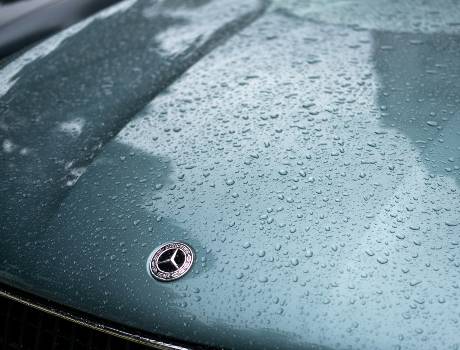
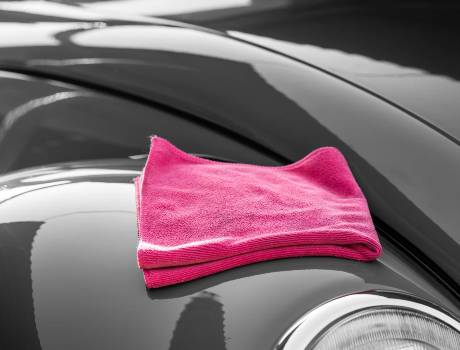

WHAT OUR CLIENTS ARE SAYING